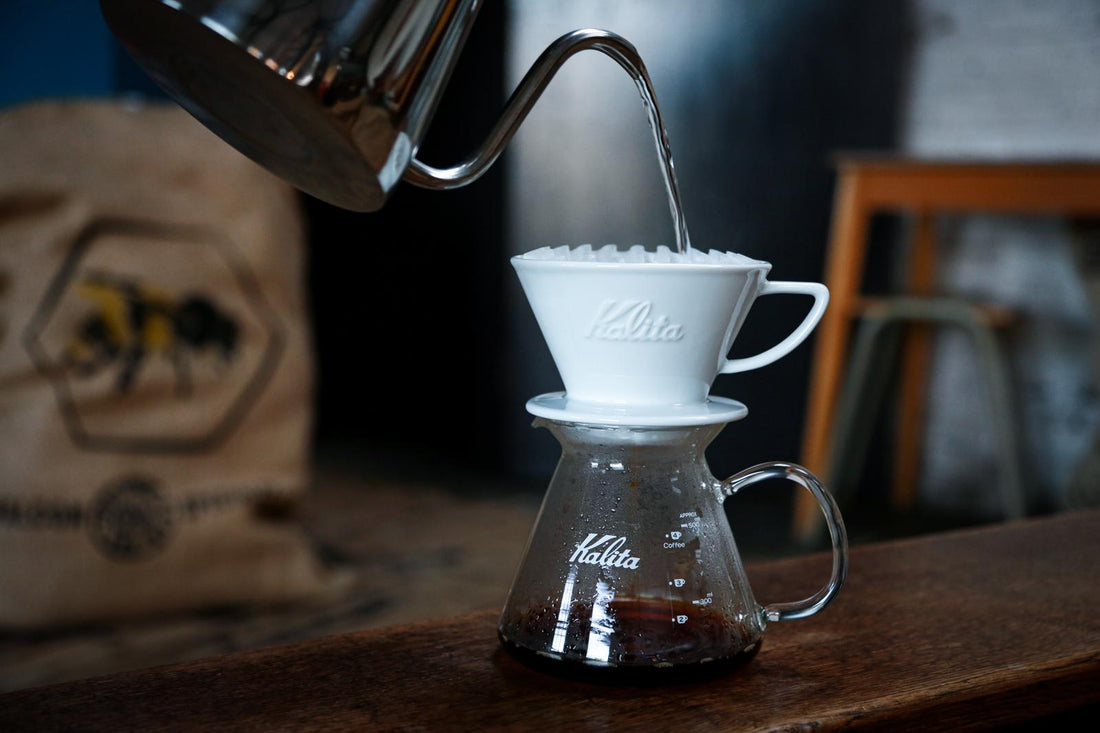By James Gallagher (Guest Blog for Steampunk Coffee)
The Kalita wave is one probably our favourite pour over brewing method. It is easy to get good results pretty quickly and yet also presents endless opportunity for experimenting and refining technique. Here our guest blogger James Gallagher, shares some observations and techniques to consider when brewing with this method.
I have been using my Kalita Wave for about a week. Suffice to say I am excited about this brew method because I have not brewed with my Aeropress since the Wave arrived. I decided to buy a Kalita Wave so I could venture into the world of coffee that is pour-over. Aeropress sort of sits in the middle between pour-over and immersion brewing. Immersion devices are those like the French press where water stays in contact with the grounds for the duration of the brew. Pour-over looked like a good place to explore next, a brewing device with a bit more ceremony and a lot of respect in the home brewing community.

The Kalita Wave was recommended by many sources I trust, and with good reason I can now say. The Kalita Wave has a flat bed filter which means that the device is less prone to clogging. Out of a week or so of brewing, my brewer has not clogged once. The device has three holes at the bottom through which water can flow, which again aids with water flow. If two holes are blocked, there will still be one left. And, notably, Kalita Wave filters, and the device itself, is widely sold on speciality coffee websites.
Now that I've been using the Wave for a week, I have a few observations to share.
Hitting my pouring goals
I use a technique of pouring called "pulsing." Pulsing is where you pour water over the coffee grounds in increments. I pour 50 grams at a time, spaced out by 30 seconds, until I reach two minutes. Then, I leave the brewer for over a minute to let most of the water draw down into my mug below. Pulsing is a good technique because it is easy to master. You just need to keep your eye on the clock.
I did some practice to help me pour water in 50 gram increments. I got pretty close on most of my tries. In one series of tests, I poured within two grams of accuracy all ten times, which I felt good about. But this was just a test and during actual brewing I sometimes overshoot that number. This morning, for instance, I poured in 56 grams of water for my bloom, and most of my 50 gram pours were off by a little bit.
I have realised I do not need to be completely accurate with my pours on the Kalita Wave. I struggle to pour exact amounts into the device and I am still able to make some delicious brews. I consider my 50 gram pours as aims rather than rules. It is important to have aims because the more consistent your technique the easier you will be able to repeat it. You'll be able to make delicious brews time and again when you find a recipe that works for you if you are consistent.
Waiting for the water to draw down
The "draw down" is the final phase of brewing where you let the rest of the water drain through the bed of coffee. At this stage, I do not need to do anything but wait. I have noticed that the draw down can take some time. I usually wait until 3:30 in my brew before I take my Kalita off my cup. I do this because most of the water has usually flowed through by this point.
I could wait longer but I've learned that it is not worth it. This is because the longer I wait, the cooler my brew will get. My Kalita brews are usually at about drinking temperature because I pour my water from an electric kettle into a gooseneck. If I waited the five or so minutes it takes for all of the water to draw down, my brew would not be at the optimal temperature. I would be waiting for a few drops of coffee.
If your draw down takes a really long time and you think it should go quicker, coarsen up your grind. A good sign you need to do this is if your water does not flow well through the bed of grounds during the main brewing phase where you keep adding water. If water is not flowing, it is a sign your grind is too fine and your filter has started to clog. Water takes a really long time to go through a clogged filter. Because of this, the water will extract more undesirable compounds from your coffee grounds that you do not want in your final brew.

Focus on the pours
This morning I tried to pour heavily on the bloom to see what would happen. I lost my focus because I was not used to this quick flow rate. My goal was to see whether a faster pour was more effective at saturating the grounds (hint: it did not seem to work, my grounds were actually less saturated overall).
A big part of brewing coffee with any pour-over device is the ritual. It looks cool when you make a Kalita brew and I feel great when I make a brew. But I need to focus on each and every pour. I keep my eye on my scales and my timer to make sure that I am pouring enough water at the right times. I make sure all of my equipment is ready before I start brewing. It is awkward to have to fuss around to get a spoon out of the drawer after I've started brewing, something I've realised once or twice because I have forgotten to get a spoon out.
It is amazing how much you learn in such a short period of time. I have enjoyed the ritual of the Kalita Wave and in the process learned a lot about how this device works. I know why this device has its reputation for being friendly for beginners. I've had a few not-so-great brews but those happen with any brewing method. Most of these have been the result of failed experiments. I have had some really delicious brews, some of which have blown me away. It has taken a bit of practice and I'm still experimenting but I love using the Kalita. It is easy to use, looks great, and is very forgiving.
Contributed by James Gallagher, a home brewer and coffee enthusiast. View his excellent blog at jamesg.blog

